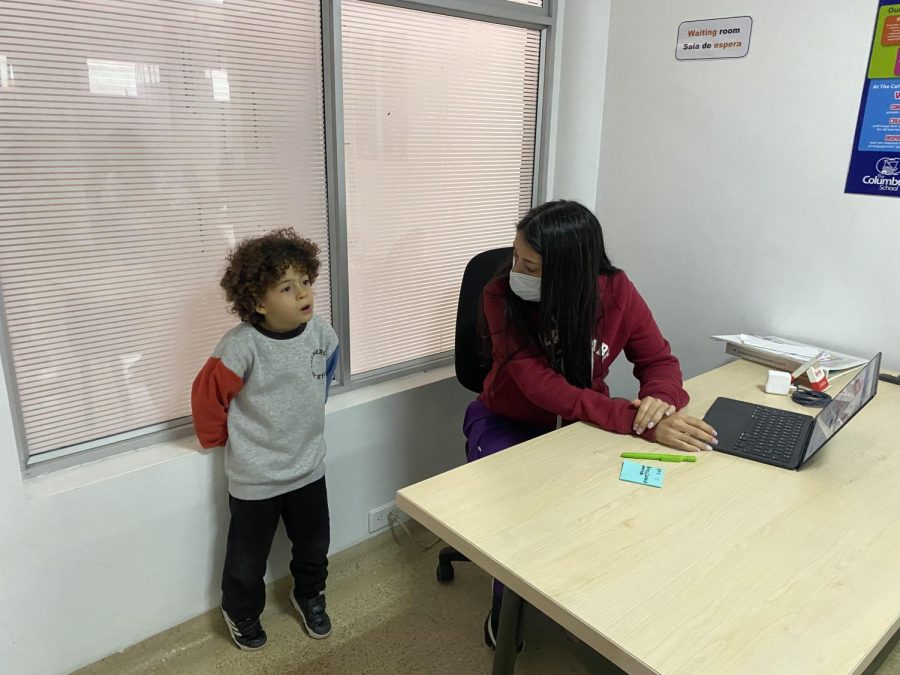The school nurse, caring for the hypochondriac
Nurse helps K4 student with a headache.
At TCS, the nurse’s office is one of the busiest places in the school. Nurses maintain a busy schedule throughout the week and their time needs to be efficiently managed to help anyone that comes in. Students, teachers, and staff members go to the nurse expecting their illness and pain to be relieved.
Nurses work 5 to 6 days a week, 10 hours per day, attending 110 patients on normal days, and more on busy days. The nurses have almost no time to relax throughout the day because of the many patients attending daily.
“On days like today, we were able to attend around 110-120, and we stay that busy every day,” Isabela Bedoya, TCS nurse, said.
9:30 am
Nurses had a couple of patients, most of them were lying down on the stretchers recovering, while others were waiting outside to be attended to. Most students are K4 and K5 who come accompanied by a teacher who later leaves. One or two teachers entered because of corporal pain, the discomfort could be seen on the teacher’s face. While one nurse attended to the teacher, another nurse would pay attention to the new students who recently arrived at the nurse’s office.
“Elementary, MS, and HS students enter alone, while generally K4 and K5 are brought by a teacher because the kids may have traumas and need someone to accompany them,” Bedoya said.
10:30 am
The nurses have not had a free moment, constantly helping several patients by giving them physical treatments, administering medicine, or being on the phone with their parents. Around this time a teacher came in asking for a wheelchair because a kid had felled and injured his ankle. In the infirmary there’s always a wheelchair in case a serious accident happens, there are also crutches that can only be used if the patient has a medical note, and TCS also provides the Castillo that the student can keep.
“In the case of crutches, it also lends, but not in cases where a student falls and says, oh, can you lend me some crutches?” Bedoya said.
11:45 am
The flow of students increases. Many patients came in groups of 2, 3, or even 4 students, and in a few minutes, the infirmary was full. At 12 it started getting messy, students entered and left at a fast and constant rate. The nurses did not have a chance to rest, helping one student after another. With time the waiting line would only grow longer.
“Working on the infirmary is not an easy job, the busiest times at the nurse are between 10-12 and 1-3,” Paula Lopez, Head Nurse, said.
The line of students waiting was so long at some point that they needed to sit outside in cushioned chairs. Some kids would be seated outside with their hands on their stomachs, others grabbing their ankles or some just with a dizzy face or disoriented look. Sometimes one nurse would call all the students waiting outside and would quickly ask them what their problem was or other simple questions that could explain what was going on as fast as possible. This way they could attend big groups of kids in a small matter of time.
“If there’s a blow to the face and leave a trauma, the parents will be notified, even though if we didn’t him give medicine,” Bedoya said.
When a student, staff, or teacher comes in it’s the same process, the nurses ask them; What’s wrong? What is the problem? Then proceed with revision and an evaluation of their related problem to figure out if they continue with physical treatments like a hot water bottle or Fresita Fria and then let them rest to see if there’s any improvement. In case there are no improvements the nurses start looking if there’s a need for medication.
“At the beginning of the year, the parents/guardian with the help of the pediatrician needs to fill out a document with the list of medications they authorize and those others that don’t,” Bedoya said.
Nurses have to contact the parents by phone call to get authorization for any medicine they want to administer. In cases where parents do not answer the medication will not be given. All the phone calls made by the nurse are stored.
1:15 pm
It is obvious that many students, especially those from MS, come to the nurse’s office just to waste time. Many students are returned to class because the nurses already know their tactics and see the individuals so often that they’re aware that the student doesn’t have real problems, just a wish to skip class. However, other students were feeling sick with a stomach aches. After just a few simple questions from the nurse, such as “Did you have lunch?” many students were sent back to eat, knowing that if the ache persisted after they ate, they could come back to the nurse.
“There are many students that we return because we already know them, we already know that they don’t eat lunch. We know that coming to the nurse is an excuse for them,” Valeria Quintero, TCS nurse, said.
2:55 pm
It is quieter now with only a few patients coming in. The drop of patients attending the office is evident since K4 and K5 students leave at 2:35, and the Elementary students finish classes at 2:55. At 3:00 pm the nurse’s office feels calm, with the absence of the students, and the nurse is almost empty, with some MS students remaining.
“Here we take all the initial care of the students, whether because they have some trauma, whether because they are presenting some pain, do like emergency care or review pain that already come from before,” Bedoya said.




